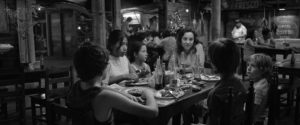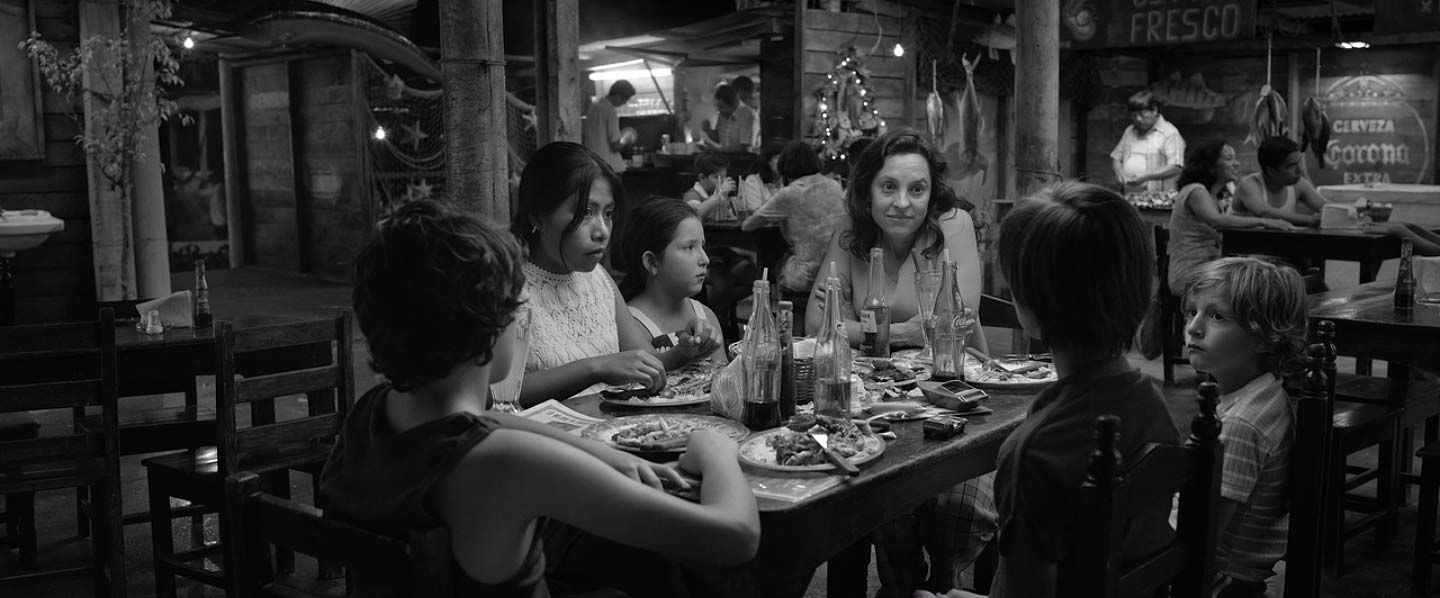Movie Info
Movie Notes
Spanish and Mixtec dialogue, English subtitles
Movie Info
- Director
- Alfonso Cuarón
- Run Time
- 2 hours and 15 minutes
- Rating
- R
VP Content Ratings
- Violence
- 3/10
- Language
- 2/10
- Sex & Nudity
- 5/10
- Star Rating
Relevant Quotes
May he defend the cause of the poor of the people, give deliverance to the needy, and crush the oppressor.

Alfonso Cuarón’s semi-autobiographical film is set in Mexico City’s “Colonia Roma” district where the houses front narrow sidewalks and streets. There are no lawns, the rooftops providing play space for children and work space for servants to iron and hang out the laundry. The director grew up in a well-off middle-class family cared for by two Mixtec women, Adela (Nancy García Garcia) and Cleo (Yalitza Aparicio). The events take place in 1970 and 1971 during the presidency of Luis Echeverría Álvarez. It was during his authoritarian rule that the infamous Corpus Christi Massacre, obliquely depicted in the film, takes place. There is turmoil not only in the streets, but also within the family and among the servants that will affect everyone.
The family consists of Antonio (Fernando Grediaga), a medical doctor, his wife Sofía (Marina de Tavira), her mother Teresa (Verónica García), and their four rambunctious children, Toño (Diego Cortina Autrey), Paco (Carlos Peralta), Pepe (Marco Graf). Of these only Sofia becomes a fully rounded character in the last half of the film. It is Cleo, nanny and maid, upon whom Cuarón focuses. He has revealed that the film is a loving tribute to his own family’s servant Libori Rodriguez. He even consulted with her while he was writing his script. Not only that, the writer/director also served as his own cinemaphotographer, thus making this as personal a film as they come.
As the primary care-giver for the children, Cleo is considered “one of the family.” She is the one who gently rouses the four little ones in the morning, sees that they get to breakfast, picks up after them and does their laundry, intervenes in their disputes, sometimes fetches the littlest one at school, and tucks them into bed at night, telling them that she loves them (they probably hear more of this from her than from their mother). She also tends to the family’s laundry. During the evening, after making sure the seated family have their snacks, she sits down casually beside them to watch TV. However, we soon see her status when Antonio wants to refill his drink. It is neither he nor Sofia who treks to the kitchen; it is Cleo. We also see that she and Adela live in small cramped rooms above the garage not much bigger than the closets of the family’s bedrooms.
Cleo is also expected (and chided about) to clean up the poop left by the family dog that is kept in the tiny car port. Indeed, the film begins underneath the credits with a long shot of a tiled floor with soapy water washing over it. We see reflected in the water a skylight and then an airliner cruising by at a high altitude. We will see such an airline many times, suggesting a distant, unknown (at least to Cleo) life. This cleansing of dog refuse will be repeated, as well as Cleo having to restrain the dog from rushing out into the street whenever a family member comes or goes. Another repetition is Antonio trying to squeeze his wide Ford Galaxy into the tiny space without scraping the sides. Later his somewhat inebriated wife will fail, stripping a long piece of chrome siding from the door. The film is filled with such quotidian details that make the story so real. Perhaps a sign of her liberation late in the film is her selling the Ford and buying compact car that easily fits into the cramped space.
Despite the demanding schedule, Cleo has a social life, in one scene going to the movies with Adela, her boyfriend, and her date Fermín (Jorge Antonio Guerrero), a friend of Adela’s boyfriend. The latter decide to skip the movie and go to a rented room where Fermin strips to the nude, takes down the shower curtain rod, and demonstrates his martial arts skill to her as she awaits him on the bed. They engage in sex, which leads several months later to her discovering she is pregnant. At the same movie theater Cleo informs Fermin that she is pregnant, whereupon he excuses himself to go the bathroom. Instead, the cad ditches her.

At this point I became anxious that she be might be cast out into the streets, a feeling that persisted throughout the rest of the film. However, Sofia seems to really mean it when she says that Cleo is “one of the family.” She accepts calmly the news of Cleo’s pregnancy and accompanies her to the clinic where her own doctor examines her.
Cleo cannot help but notice the dissolution of Sofia’s marriage after Antonio goes to a conference in Quebec, returns, and leaves again on the excuse of having to finish his business there. There are phone calls and conversations among the adults that she overhears. Sofia tries to keep up the pretense with the children that their father has been in touch with them and will return. But he is not home for Christmas, nor at New Year’s when the family packs up and travels to an uncle’s hacienda where their host holds an annual fire-works display for family and friends. One of the bizarre details of the New Year’s episode is the camera’s panning around the rooms to show the trophy heads of the many dogs the family has owned.
Also, a bit bizarre is the disappointing trip to a training camp to which Cleo, traveling by herself, has tracked down Fermin. Several of the unusual touches of this sequence are the muddy squalor of the surroundings; a background scene of a political rally featuring a human canon ball being shot out of a giant gun; and the militaristic look of the hundreds of young men going through their martial arts moves, following which they are addressed by a strangely garbed guru. When she confronts her lover after the assembly, he refuses to admit his paternity, even threatening to kill her if she contacts him again.
Sofia’s mother Teresa escorts the now almost due Cleo to a furniture store to pick out a crib for the baby. This is June 10, 1971, and the pair witness lorries filled with armed soldiers waiting as thousands of students demonstrate against the government and others kneel on the sidewalks to paint banners. The attack by the soldiers is shown through the windows through which Cleo and Teresa peer, their horror magnified when a couple of terrified students are chased by gun-wielding thugs who catch up and execute them. Cleo is especially shocked by the identity of one of the thugs.
This shock causes Cleo’s water to break, and Teresa struggles to get her charge through the thronged streets where people are mourning over the dead bodies of the slain (120 students were murdered that day). The detailed birth scene ends as disappointingly as Cleo’s trip to confront Fermin.
We see the break between Sofia and Antonio finalized when the wife packs up the household and transports everyone to Veracruz, allegedly for a vacation, but in reality to permit the husband to come and haul away his possessions, including the bookcases with their glass doors that dominate most of the room. It is while at the beach that the non-swimmer Cleo summons the courage to risk her own life in the saving of two of the children, an act that apparently assures her a place in the family forever.
Alfonso Cuarón’s viewpoint, his focusing in on the lowliest “member of the family,” is very much in keeping with the Bible’s emphasis upon God’s caring for “the least of these, my brothers.” This theme runs throughout Scriptures, as it does through this film, though Cuarón never devolves into homilizing. He shows, rather than tells, by a multitude of details how vulnerable Cleo is. She herself is very passive, except for the instance of her traveling to confront her seducer and her risking her life at the sea shore for the children. She speaks so little, that one of the children says at one point that she is mute. Cleo receives many hard blows from life, but she is not depicted as just a victim. No, rather, we see that she is one of life’s givers, love flowing from her each night through her words, and throughout the day through her many kind acts. Love begets love, and this we see in that both the children and their mother respond to her in kind. Their status in a society obsessed with wealth will always be unequal, but it will be a warm and mutually supportive relationship.
Cuarón does develop Sofia’s character further in the last half of the film. Distraught when she is forced to accept his rejection of her, she comments, “We are alone. No matter what they tell you, we women are always alone.” (This is something that Cleo can relate to, given her treatment by Fermin.) Sofia emerges from her husband’s shadow as a more resilient person, stating that she can support the family with her new job at a publishing house. When it is pointed out that she had been a bio-chemist, she responds that she had not liked that field but had been made to go into it. Not so well fleshed out are the four children. We see them as a unit, imaginative and loving, always awhirl with activities, into which Cleo sometimes enters, such as when one boy quits playing war with his older brother. Falling down “dead,” he is joined in a prone position by Cleo. When she does not reply to his query, she tells him she cannot because she is “dead.” We might wish to see more of the children, but Cuarón is more interested in the gentle woman who shaped his early life than he is in himself.
Shot in sparkling black and white, the film might remind viewers of the neo-realistic style of such post-WW 2 filmmakers as Roberto Rossellini and Federico Fellini—indeed, the latter made in 1972 a film of the same title, which also was autobiographical. Cuarón‘s might be a domestic tale, but the larger turmoil of Mexican society is never far away. The premonition of troubles, large and small, occurs when an earthquake shakes the hospital while Cleo and Sofia first visit the clinic there. Cloe looks in the baby ward as the nurses frantically scramble to carry the infants to a safer place. Large pieces of plaster land atop one of the preemie cubicles. At the end of this sequence the camera shows us three large crosses, leaving us to reflect on their connection to the story.
This is one of those great films that will leave viewers with a great many things to think about. The nude love scene between Fermin and Cleo (a reversal of most such depictions in that the full-frontal shot is of the man) might make this a controversial choice for some religious groups, but for others, this is just the kind of film that can lead to a great discussion. And thanks to Netflix, even those lacking access to an arthouse theater can gather and watch it at home or their place of worship and education.
This review will be in the February issue of VP along with a set of questions for reflection and/or discussion. If you have found reviews on this site helpful, please consider purchasing a subscription or individual issue in The Store.

